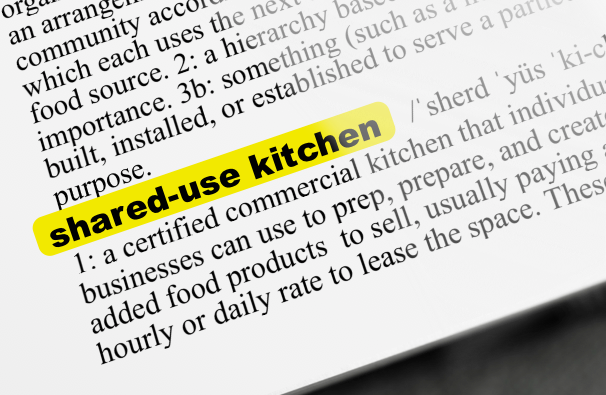A simple definition of a shared-use kitchen is a certified commercial kitchen in which individuals or businesses prepare value-added food products and meals, usually paying an hourly or daily rate to lease a space shared by others. These spaces are most often used by culinary or packaged food entrepreneurs and can have positive social, economic, and health impacts on a community. The term shared-use kitchen is sometimes used synonymously with commercial kitchen, certified kitchen, kitchen incubator / incubator kitchen, food business accelerator, commissary kitchen, community kitchen, etc. While a shared-use kitchen may be found in conjunction with these types of kitchens, they do not always mean the same thing. So to round out the definition of a shared-use kitchen, we will define these other terms as well.
shared-use kitchen noun : a certified commercial kitchen in which individuals or businesses prepare value-added food products and meals, usually paying an hourly or daily rate to lease a space shared by others
Commercial kitchens are not a new phenomena. Every restaurant, college or dining service and some elementary schools and churches will have a commercial kitchen that has industrial grade equipment to feed large numbers. Many communities are turning these facilities into shared-use kitchens that can be rented by the hour, or made available free of charge, to serve members of the community who need a larger kitchen for private events or for personal / hobby food production. This is sometimes called a community kitchen. Entrepreneurs who make products or meals as a business would use this type of commercial grade, certified kitchen space in order to sell food to the public, because it meets the regulatory requirements for venting, sanitation and food safety. This is particularly important for farmers who want to process and sell value-added items that bring additional income, or for food hubs to lightly process raw fruit and vegetables to be sold to schools and other institutions in the forms that they need.
Kitchen Incubators (= incubator kitchens = food business incubators) have been on the rise in the last decade, with 200 incubator kitchens reported in the U.S. in 2016 by Econsult Solutions, a 50% increase in just three years. As food entrepreneurship, start-up culture, buy local campaigns, and small batch processing have become intertwining trends in most U.S. cities, the need for processing and kitchen prep space has grown tremendously. Almost all kitchen incubators provide the space for entrepreneurs to produce—whether in a shared-use kitchen rented by the hour or day, or in a private, dedicated space leased by the month or year—which can dramatically increase the number of food business startups because they do not need to make the large and risky upfront investment in facilities and equipment.
For these reasons and those cited above, we see municipalities increasingly investing in commercial kitchens and food business incubators. They can boost farmer incomes, make better food available in schools and hospitals, and spur economic growth.
What makes a kitchen incubator different from a shared-use kitchen is the wrap-around support services kitchen incubators provide. They help small food businesses with production, marketing, packaging, gaining distribution, etc. What makes a food business accelerator different from a food business incubator is twofold: the later stage of development of the food business, and that most accelerators do not provide production space (entrepreneurs may be producing in a shared-use kitchen, kitchen incubator or with a co-packer). Accelerator programs usually run for three to six months, help food businesses rapidly scale and sometimes assist in raising capital to do so.
To learn more about what makes incubator kitchens successful and the right mix of features needed for such a facility, check out this piece from the NVA archives on Kitchen Incubators: Is there a recipe for success? which outlines everything from pricing models to storage services to common pitfalls of operating an incubator kitchen.
OK we snuck in another term: co-packer. A co-packer, or contract manufacturer, is an independent party that operates a large commercial production facility to make food products for a large number of customers that are sold under the customers’ brand names. Smaller scale co-packing facilities are sometimes referred to as commissary kitchens, where production for a number of customers is centralized in one facility using a facility-managed crew. Commissary kitchens can also be operated by an individual company or organization that has multiple outlets. Some school districts have commissary kitchens where meals are prepped and then delivered and served at each school. Today, commissary kitchens are increasingly associated with food trucks. This is the common term used for the type of shared-use kitchen where food truck operators prep the meals they vend from their trucks.
NVA has also worked on dozens of projects that involve business planning for or the design of shared-use commercial and incubator kitchens; you can see some of them here. Plus, we have a great free tool for doing some quick capacity modeling for a planned kitchen incubator space—head over to the NVA Toolsite to use our Kitchen Facility HubSizer® tool!




So glad to see this post. We have a couple additional resources for folks that want to dig in more:
1. Network for Incubator and Commissary Kitchens – (or NICK) is the largest network of shared-kitchen operators in the world. It is a private Facebook community to share best practices, ask questions, and build professional relationships in the emerging shared-kitchen industry. (http://www.thefoodcorridor.com/thenick/)
2. The Shared Kitchen Toolkit – In response to these trends and increasing industry demand for shared kitchen resources, The Food Corridor, Fruition Planning and Management, and Purdue Extension Services co-created the Shared Kitchen Toolkit: A Practical Guide to Planning, Launching, and Managing a Shared-Use Commercial Kitchen
The Shared Kitchen Toolkit is a free, web-based resource that delivers guidance on feasibility and planning for new kitchen projects, as well as management practices for the day-to-day operations of shared-use kitchens. It also provides an overview of emerging kitchen models and highlights opportunities for kitchens to expand their community impact and enhance financial sustainability. It is available as a 166-page downloadable PDF, via The Food Corridor’s resources page. (http://www.thefoodcorridor.com/announcing-the-shared-kitchen-toolkit/)
Thanks, Ashley, for providing additional resources for our readers!